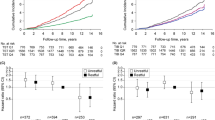Abstract
The Sleep Heart Health Study (SHHS) is a prospective cohort study using participants from several ongoing cardiovascular and respiratory disease research projects to investigate the relationship between sleep-disordered breathing and cardiovascular disease. This study design required unusual and different recruiting techniques to meet the study’s enrollment goal of between 6000 and 6600 participants. Individuals were recruited to undergo an overnight home polysomnogram, completion of several questionnaires, and collection of a small amount of physical examination data. This article describes the methods used to recruit these participants and how these procedures influenced the final participation rate and the representativeness of SHHS to its parent cohorts. Of 30,773 people eligible for recruitment into SHHS, attempts were made to enroll 11,145 (36%). Of those contacted, 6441 ultimately agreed to participate (58%). Recruitment rates (38 to 91%) varied among sites. SHHS participants were slightly younger (63.0 vs. 65.0 years, p < 0.001), had more years of education (14.1 vs. 13.7, p < 0.001), more likely to snore (34% vs. 23%, p < 0.001), had higher Epworth sleepiness scores (7.7 vs. 6.5, p < 0.001), slightly higher higher systolic and diastolic blood pressures (127.6/73.9 vs. 127.2/72.1, p < 0.001 for diastolic only), and a slightly higher body mass index (BMI) (28.5 vs. 27.5, p < 0.001). We conclude that it is feasible to recruit existing participants from one large-scale epidemiologic study into another with a high degree of success. However, the characteristics of the new cohort may vary in several respects from their original cohorts and therefore interpretation of study results will have to consider these differences.
Similar content being viewed by others
References
Quan SF, Howard BV, Iber C, et al. The Sleep Heart Health Study: design, rationale, and methods. Sleep 1997;20:1077–1085
Dawber TR, Kannel WB, Lyell LP. An approach to longitudinal studies in a community: the Framingham study. Ann N Y Acad Sci 1963;107:539–556
The Atherosclerosis Risk in Communities (ARIC) study: design and objectives. Am J Epidemiol. 1989;129:687–702
Fried LP, Borhani NO, Enright P, et al. The cardiovascular health study: design and rationale. Ann Epidemiol 1991;1:263–266
Lee ET, Welty TK, Fabsitz R, et al. The Strong Heart Study—a study of cardiovascular disease in American Indians: design and methods. Am J Epidemiol 1990;132:1141–1155
Lebowitz MD, Knudson RJ, Burrows B. Tucson Epidemiologic Study of Obstructive Lung Disease: I. Methodology and prevalence of disease. Am J Epidemiol 1975;102:137–152
Quackenboss JJ, Lebowitz MD, Hayes C. Epidemiological study of respiratory responses. Environ Int 1989;15:493–502
DiPede C, Viegi G, Quackenboss JJ, Boyer-Pfersdorf P, LebowitzMD. Respiratory symptoms and risk factors in an Arizona population sample of Anglo and Mexican-American whites. Chest 1991;99:916–922
James GD, Toledano T, Dantz G, PickeringTG. Factors influencing the awake-sleep difference in ambulatory blood pressure: main effects and sex differences. J Hum Hypertens 1995;9:821–826
Schnall PL, Schwartz JE, Landsbergis PA, Warren K, PickeringTG. Relation between job strain, alcohol, and ambulatory blood pressure. Hypertension 1992;19:488–494
Redline S, SandersMH, Lind BK, et al. Methods for obtaining and analyzing unattended polysomography data for a multicenter study. Sleep 1998;21:759–767
Johns MW. A new method for measuring daytime sleepiness: the Epworth Sleepiness Scale. Sleep 1991;14:540–545
Bloom JW, Kaltenborn WT, Quan SF. Risk factors in a general population for snoring. Importance of cigarette smoking and obesity. Chest 1988;93:678–683
Douglas JG, Thibonnier M, Wright JrJT. Essential hypertension: racial/ethnic differences pathophysiology. J Assoc Acad Minor Phys 1996;7:16–21
Kannel WB, Feinleib McNamaraPM, Garrison RJ, Castelli WP. An investigation of coronary heart disease in families: the Framingham Offspring Study. Am J Epidem 1979;110:281–290
Shahar E, Folsom AR, JacksonR. The effect of nonresponse on prevalence estimates for a referent population: insights from a population-based cohort study. Ann Epidemiol 1996;6:498–506
Tell GS, Fried LP, Hermanson B, ManolioTA, Newman AB, Borhani NO. Recruitment of adults 65 years and older as participants in the Cardiovascular Health Study. Ann Epidemiol 1993;3:358–366
Stoddart ML, Jarvis B, Blake B, et al. Recruitment of American Indians in epidemiologic research: the Strong Heart Study. Am Indian Alsk Native Ment Health Res 2000;9:20–37
Higgins M, Province M, Heiss G, et al. NHLBI Family Heart Study: objectives and design. Am J Epidemiol 1996;143:1219–1228
Tell GS, Lefkowitz DS, Diehr P, ElsterAD. Relationship between balance and abnormalities in cerebral magnetic resonance imaging in older adults. Arch Neurol 1998;55:73–79
Schulz R, Newson J, Mittelmark M, Burton L, Hirsch C, Jackson S. Health effects of caregiving: the Caregiver Health Effects Study: an ancillary study of the Cardiovascular Health Study. Ann Behav Med 1997;19:110–116
Young T, Palta M, Dempsey J, Skatrud J, Weber S, Badr S. The occurrence of sleep-disordered breathing among middle-aged adults. N Engl J Med 1993;328:1230–1235
Ancoli-Israel S, Kripke DF, Klauber MR, Mason WH, FellR, Kaplan O. Sleep-disordered breathing in community-dwelling elderly. Sleep 1991;14:486–495
Author information
Authors and Affiliations
Corresponding author
Rights and permissions
About this article
Cite this article
Lind, B.K., Goodwin, J.L., Hill, J.G. et al. Recruitment of Healthy Adults into a Study of Overnight Sleep Monitoring in the Home: Experience of the Sleep Heart Health Study. Sleep Breath 7, 13–24 (2003). https://doi.org/10.1007/s11325-003-0013-z
Issue Date:
DOI: https://doi.org/10.1007/s11325-003-0013-z




